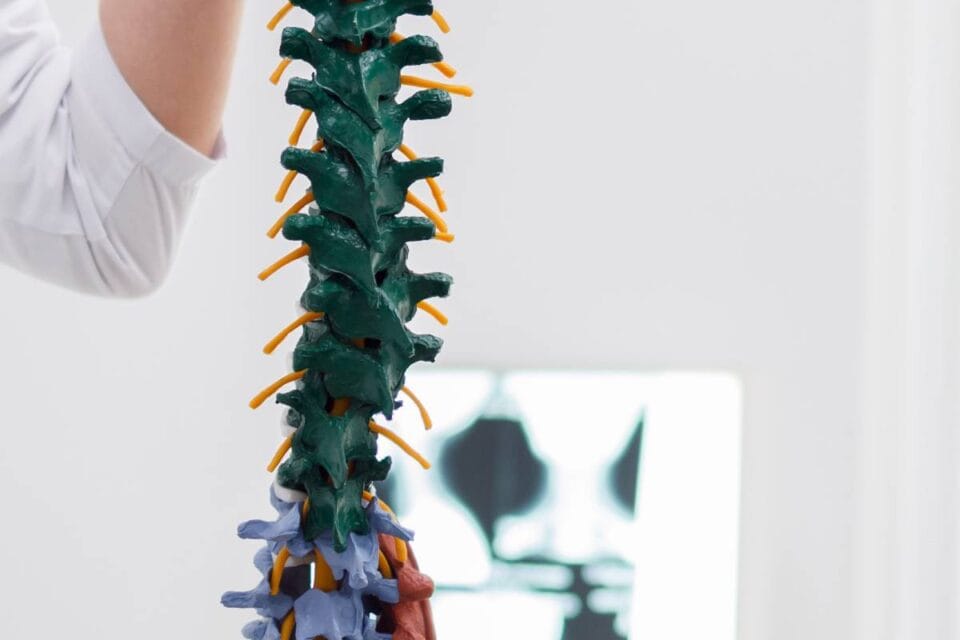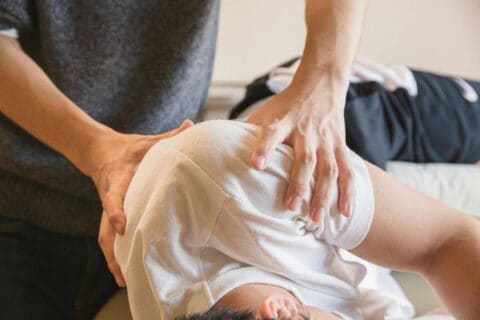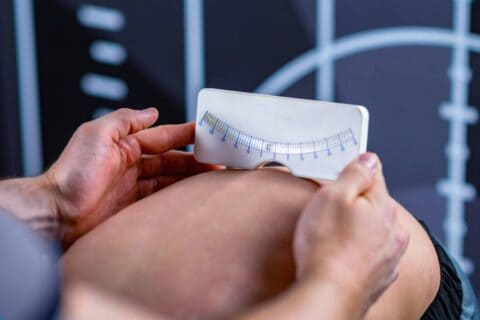Have you ever considered how your spine’s shape affects your daily life? As a chiropractor, I’ve seen countless patients whose lives have been transformed by addressing their spinal curvature. Here’s a startling fact: studies show that people with spinal curvature disorders have a significantly higher risk of injury compared to those without. This isn’t just about back pain – it’s about your overall well-being. Join me as we explore the crucial role of your spine’s natural curves, the ripple effects when they’re compromised, and how we can work together to maintain or restore your spinal health.
Key Takeaways
- Loss of spinal curvature can lead to significant physical, neurological, and quality-of-life impacts
- Early detection and intervention are crucial for preventing long-term complications
- A multidisciplinary approach, including chiropractic care, can effectively manage and potentially reverse spinal curvature loss
Is SpineMed Your Path to a Pain-Free Life?
Tired of living with back pain? Take our quick quiz to see if you’re a candidate for the breakthrough SpineMed Treatment. It only takes a few minutes to potentially change your life.
Understanding Spinal Curvature
The human spine is a marvel of engineering, featuring three main curves that work in harmony to support our body’s functions: cervical lordosis (the inward curve in the neck), thoracic kyphosis (the outward curve in the upper back), and lumbar lordosis (the inward curve in the lower back).
These curves serve several critical functions, including distributing body weight evenly, providing flexibility for movement, and absorbing shock to protect the spine from injury.
When these curves begin to flatten or reverse, we start to see problems such as loss of cervical lordosis, flatback syndrome, or scoliosis. These conditions can significantly impact the spine’s ability to function optimally, leading to a range of health issues that extend far beyond simple back pain.
Causes of Spinal Curvature Loss
Several factors can contribute to the loss of natural spinal curves. Poor posture, particularly when maintained over long periods, can gradually alter spinal alignment. Degenerative disc disease, a common result of aging, can lead to a loss of disc height and consequently affect spinal curvature.
Trauma and injuries, such as those sustained in accidents or falls, can also alter spinal alignment. Some individuals are born with congenital conditions that affect spinal curvature, while in rare cases, surgical complications can inadvertently impact the spine’s natural curves.
In our modern world, the increasing use of technology has introduced new challenges to spinal health. Prolonged use of smartphones and computers can lead to what’s known as “tech neck”, a condition where the neck’s natural curve is compromised due to constant forward head posture. This modern phenomenon highlights the importance of maintaining awareness of our posture in an increasingly digital world.
![Effects Of Losing The Curvature Of The Spine [Explained] Effects Of Losing The Curvature Of The Spine](https://thebodyfixchiro.com/wp-content/uploads/EffectsOfLosingTheCurvatureOfTheSpine3.jpg)
Physical Effects of Losing Spinal Curvature
The loss of natural spinal curves can have far-reaching physical consequences1. It leads to biomechanical changes that compromise the spine’s ability to distribute forces efficiently. This results in increased stress on spinal structures, including vertebrae, discs, and ligaments, which experience accelerated wear and tear. Muscle imbalances and tension often develop as some muscles overcompensate while others weaken. Over time, this can lead to reduced spinal flexibility and mobility, impacting overall range of motion and daily functionality.
These physical changes don’t occur in isolation. They can trigger a domino effect, influencing everything from how we move and breathe to how our internal organs function.
The body is an interconnected system, and changes in spinal curvature can resonate throughout, affecting overall health and well-being in ways that might not be immediately apparent.
Neurological Consequences
The spine plays a crucial role in the nervous system, and alterations in its curvature can have significant neurological implications. In severe cases, spinal cord compression can occur, leading to a range of neurological symptoms. Nerve root impingement is another common issue, often resulting in localized or radiating pain. Radicular symptoms, including pain, numbness, or tingling that radiates along the path of a nerve, can significantly impact quality of life.
In more serious cases, myelopathy – compression of the spinal cord itself – can lead to more severe neurological issues.
Even balance and proprioception can be affected, as changes in spinal alignment influence the body’s sense of position and balance.
These neurological effects underscore the importance of maintaining proper spinal curvature for overall nervous system health and highlight the far-reaching consequences of spinal misalignment.
Pain and Discomfort
Loss of spinal curvature often manifests as various types of pain. Neck pain and cervicogenic headaches are commonly associated with loss of cervical lordosis2. Back pain patterns can vary depending on which spinal curves are affected, sometimes presenting as a dull ache and other times as sharp, localized pain. In many cases, pain may not be confined to the back or neck but can refer to the extremities, radiating down the arms or legs.
For some individuals, these pain symptoms can evolve into chronic pain syndromes, persisting over extended periods and significantly impacting daily life. It’s crucial to understand that pain is the body’s way of signaling that something is amiss. While it can be tempting to mask pain with medication, addressing the underlying spinal issues is essential for long-term relief and overall health.
Postural and Aesthetic Impact
Changes in spinal curvature can have visible effects on posture and appearance. Forward head posture is often seen with loss of cervical lordosis, giving the impression that the head is jutting forward from the body. In some cases, particularly with significant loss of cervical curve, a “military neck” appearance may develop, where the neck appears straighter than normal.
These postural changes can lead to a reduction in overall height as the spine compresses and loses its natural curves. Body proportions may appear altered, affecting overall symmetry and potentially impacting self-image and social interactions. While these changes may seem primarily cosmetic, they often reflect deeper structural issues that can have significant implications for long-term health and well-being.
Impact on Daily Activities and Quality of Life
The effects of spinal curvature loss extend far beyond occasional discomfort, permeating many aspects of daily life. Sleep quality often suffers as individuals struggle to find comfortable positions that don’t exacerbate pain or discomfort. Physical activities and exercise may become more challenging, leading to a more sedentary lifestyle that can further compound spinal health issues.
Even routine tasks can become arduous, requiring more effort or causing discomfort. This can range from difficulty in reaching overhead to discomfort while sitting for extended periods. Work productivity can be significantly affected, especially in jobs requiring prolonged sitting or physical labor. The cumulative effect of these challenges often results in a decrease in overall quality of life, underscoring the importance of addressing spinal curvature issues promptly and effectively.
![Effects Of Losing The Curvature Of The Spine [Explained] Effects Of Losing The Curvature Of The Spine](https://thebodyfixchiro.com/wp-content/uploads/EffectsOfLosingTheCurvatureOfTheSpine-.jpg)
Technological Influences on Spinal Health
In our digital age, technology plays a significant role in spinal health. Prolonged use of devices often contributes to poor posture and the development of “tech neck.” The sedentary lifestyle often associated with excessive technology use can lead to weakened core muscles, further compromising spinal support.
However, technology isn’t all bad news for spinal health. Innovations such as posture-tracking apps and ergonomic tools can help individuals maintain better spinal alignment throughout the day.
Virtual reality is even being explored as a tool for patient education and rehabilitation, offering new ways to understand and address spinal health issues. The key lies in balancing technology use with proper ergonomics and regular movement to maintain optimal spinal health in our modern world.
Diagnosis and Assessment
Accurate diagnosis of spinal curvature issues involves a comprehensive approach. A thorough clinical examination assesses posture, range of motion, and neurological function. Imaging studies such as X-rays, MRIs, and CT scans provide detailed views of spinal structure, allowing for precise measurement of spinal curves and identification of any underlying issues.
Postural analysis, often aided by specialized software, can provide an in-depth understanding of how spinal curvature changes are affecting overall body alignment. Functional movement screening evaluates how the spine moves during various activities, offering insights into how curvature issues are impacting daily life. This multi-faceted approach to diagnosis ensures a comprehensive understanding of each individual’s spinal health, forming the foundation for an effective, personalized treatment plan.
Treatment Approaches
Addressing spinal curvature loss requires a comprehensive strategy, with chiropractic care at the forefront. As a chiropractor, I’ve seen firsthand how targeted spinal adjustments can significantly improve alignment and function. Our approach combines hands-on manipulation with advanced techniques to gently restore proper curvature.
At The BodyFix, we’re proud to offer the SpineMed Decompression Protocol, a cutting-edge non-surgical solution for chronic back pain and disc-related issues. This advanced spinal decompression technology allows us to provide personalized treatment plans that offer lasting relief and promote optimal spinal health.
We complement these treatments with customized exercise programs and posture correction strategies, empowering you to maintain improvements between sessions. This holistic approach not only addresses current issues but also helps prevent future problems.
While our chiropractic care and SpineMed treatments are often highly effective, some cases may benefit from additional interventions. These might include supplements or other conservative therapies. Our goal is always to use the least invasive, most effective methods to help you achieve optimal spinal health.
Using Chiropractic Care to Treat Cervical Lordosis
Chiropractic care has shown compelling evidence in improving cervical lordosis.3
As specialists in spinal alignment, chiropractors can develop comprehensive treatment plans to address neck dysfunction over several weeks or months. One study demonstrated significant improvements in a patient’s cervical lordosis after just 3.5 months of chiropractic adjustments, along with overall improvements in neck alignment.
The medical community widely recognizes the importance of proper neck curvature for overall health, as it protects spinal health and can prevent unnecessary headaches and muscle pain. 4
While there’s some debate over the best techniques to treat this issue, seeking consultation with a chiropractor who specializes in correcting postural alignment issues, particularly with experience in cervical spine treatment, can be a beneficial step for those concerned about abnormal neck curvature causing pain.
Pediatric Considerations
Spinal health in children requires special attention. Early detection of spinal issues can prevent long-term problems, making regular check-ups crucial.
As children grow, their spines undergo significant changes, and monitoring these changes closely can help identify and address any developing issues promptly.
Education plays a key role in pediatric spinal health. Teaching children about proper backpack use and weight distribution can prevent unnecessary strain on developing spines. 5Moreover, instilling good posture habits early on can set the foundation for lifelong spinal health. By investing in children’s spinal health early, we can potentially prevent a host of issues in adulthood, promoting better overall health and quality of life in the long term.
Occupational Hazards and Workplace Ergonomics
Many occupations can significantly impact spinal health, with certain professions putting extra stress on the spine. Recognizing these risks is the first step in prevention. Implementing proper ergonomic workplace design is crucial for maintaining spinal health, particularly in jobs that require prolonged sitting or repetitive movements.
Regular movement breaks can help prevent stiffness and maintain good posture, even in sedentary jobs. The use of ergonomic tools and equipment can further support proper spinal alignment throughout the workday. It’s important for both employers and employees to work together in creating spine-friendly work environments, recognizing that investments in ergonomic solutions can pay dividends in employee health and productivity.
Psychological and Social Implications
The impact of spinal curvature loss extends beyond physical health, often affecting psychological well-being and social interactions6. Changes in posture can significantly impact body image and self-esteem, particularly when they result in visible changes to one’s appearance. The chronic pain often associated with spinal issues can lead to mood changes, potentially contributing to depression or anxiety.
Physical limitations resulting from spinal curvature loss may affect social interactions and activities, sometimes leading to a sense of isolation or decreased quality of life. Developing healthy coping strategies becomes crucial in managing these psychological and social impacts. A holistic approach to treatment that addresses both the physical and psychological aspects of spinal health is essential for comprehensive care and overall well-being.
Prevention and Long-term Management
Maintaining spinal health is an ongoing process that requires consistent effort and awareness. Implementing ergonomic principles in daily life, from how we sit at our desks to how we sleep at night, can go a long way in preserving spinal curvature7. Adopting a healthy lifestyle with regular exercise and proper nutrition supports overall spinal health, providing the strength and nourishment needed for optimal function.
Performing maintenance exercises specifically designed to support spinal alignment can help prevent issues before they arise. Regular check-ups with healthcare providers allow for early detection and intervention of any developing problems. By taking a proactive approach to spinal care, many issues can be prevented, maintaining overall health and well-being for years to come.
Personalized Chiropractic Care in Mt. Pleasant
At The BodyFix, we offer a unique approach to chiropractic treatment designed to address your specific needs and help you achieve optimal health and wellness.
We understand that each patient’s spinal health needs are unique, which is why our personalized approach takes into account your individual circumstances, lifestyle, and health goals.
Using state-of-the-art diagnostic tools and techniques, we develop comprehensive treatment plans tailored specifically to you.
Our treatments may include spinal adjustments, targeted exercises, posture correction techniques, and lifestyle recommendations. We also focus heavily on patient education, empowering you to take an active role in maintaining your spinal health long after you leave our office.
Is SpineMed Your Path to a Pain-Free Life?
Tired of living with back pain? Take our quick quiz to see if you’re a candidate for the breakthrough SpineMed Treatment. It only takes a few minutes to potentially change your life.
FAQs
Can loss of spinal curvature be reversed?
How long does it take to see improvements in spinal curvature with treatment?
Are there any non-invasive treatments for restoring spinal curvature?
Can poor sleeping posture contribute to spinal curvature loss?
What role does nutrition play in maintaining spinal health?
Conclusion
The loss of spinal curvature is a complex issue with far-reaching effects on physical health, daily functioning, and overall quality of life. However, with early detection, proper care, and a proactive approach to spinal health, many of these issues can be effectively prevented or managed. Remember, your spine is unique, and so should be your care. Working with a healthcare professional who can provide personalized treatment is key to achieving and maintaining optimal spinal health.
If you’re concerned about your spinal health or experiencing any symptoms we’ve discussed, we encourage you to take action. Schedule a consultation with us today. We’ll perform a thorough assessment, discuss your concerns, and develop a personalized treatment plan to help you achieve optimal spinal health.
- https://www.ncbi.nlm.nih.gov/pmc/articles/PMC3705911/ ↩︎
- https://pmc.ncbi.nlm.nih.gov/articles/PMC10024460/ ↩︎
- https://www.ncbi.nlm.nih.gov/pmc/articles/PMC8752283/ ↩︎
- https://spinehealth.org/article/taking-care-of-your-neck-the-importance-of-motion-and-alignment/ ↩︎
- https://spinehealth.org/article/backpacks-back-pain-children/#:~:text=Consider%20weight%20distribution,reduces%20strain%20on%20their%20spine. ↩︎
- https://spinehealth.org/article/adult-spinal-deformity/ ↩︎
- https://spinehealth.org/article/spine-posture-workplace-ergonomics/ ↩︎
Blog Disclaimer: The information provided on The BodyFix Chiro blog is for general informational and educational purposes only and is not intended as medical advice. These articles reflect our opinions and experiences but should not be used to diagnose or treat any health conditions. Always consult with your physician, chiropractor, or other qualified healthcare provider before starting any new treatment, exercise program, or making changes to your health routine. Any actions you take based on information from this blog are entirely at your own risk, and The BodyFix Chiro and its contributors disclaim any liability for the decisions you make based on this information.




